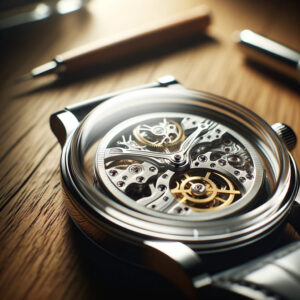Why Do Watches Lose Time & How Do Watches Keep Time?

Timekeeping has been a cornerstone of human civilizations, providing structure to our days and ensuring the synchronization of activities. In this pursuit of accurate time, watches have emerged as quintessential tools, blending craftsmanship with functionality to keep us on track. Despite the remarkable precision of both mechanical and quartz watches, a paradox exists in their operation — the inevitable drifting from accurate time. This phenomenon, where watches lose time, might seem counterintuitive given their primary function of timekeeping. Yet, it highlights the complex interplay of internal mechanisms, from oscillation and friction to jeweled movements, all contributing to how watches keep time. In exploring this intriguing contradiction, we delve into the reasons behind time loss in watches and the principles guiding their timekeeping abilities, shedding light on the perpetual dance between accuracy and the forces that challenge it.
How Do Watches Keep Time
Understanding how watches keep time is pivotal in comprehending why watches lose time. The evolution from mechanical to quartz, and finally to atomic watches, showcases the advancements in timekeeping precision and technology.
Overview of Mechanical Watches
Mechanical watches, lauded for their craftsmanship, operate on a complex movement mechanism. The heart of this mechanism is the mainspring, a coiled spring that, when wound, releases energy. This energy is regulated by the escapement and gears, converting it into a measured release that moves the watch's hands.
- Movement mechanism: Powered by the unwinding of the mainspring.
- Escapement and Gears: Control the release of energy to measure time precisely.
- Mainspring: Stores energy and is the power source of the watch.
Overview of Quartz Watches
Quartz watches revolutionized timekeeping with their accuracy and reliability, surpassing mechanical watches.
- Quartz Crystal: The heart of a quartz watch; it oscillates at a consistent frequency when subjected to an electric field.
- Battery: Provides the electric charge to the quartz crystal, initiating oscillation.
- Electronic Circuits: Count the number of vibrations (oscillations) of the quartz crystal to keep accurate time.
Overview of Atomic Watches
Representing the zenith of timekeeping accuracy, atomic watches synchronize with an atomic clock.
- Principle: Utilizes the precise vibration frequency of atoms to keep time.
- Radio Signals: Synchronize the watch with an atomic clock, ensuring unparalleled accuracy.
| Type of Watch | Key Component | Mechanism | Precision Source |
|---|---|---|---|
| Mechanical | Mainspring, Escapement | Mechanical movement powered by mainspring | Gears and Escapement |
| Quartz | Quartz Crystal, Battery | Electric field causes crystal oscillation | Crystal Oscillation |
| Atomic | Radio Signal Reception | Synchronization with atomic clock via radio signals | Atomic Timekeeping |
In the discussion surrounding "Why Do Watches Lose Time & How Do Watches Keep Time?", it becomes evident that technological advancements in watches are geared toward combating time loss, enhancing precision, and optimizing reliability. The transition from mechanical, through quartz, to atomic timekeeping illustrates the industry's commitment to accuracy and the constant pursuit of perfection in timekeeping.
Factors Influencing Watch Accuracy
Mechanical Watch Factors
Mechanical watches, with their intricate internal mechanisms, can be affected by several factors:
- Wear and Tear: Over time, the parts of a mechanical watch can wear down, affecting its timekeeping abilities.
- Temperature Variations: Extreme temperatures can cause the metal components to expand or contract, altering timing precision.
- Magnetism: Exposure to magnetic fields can impact the watch's movement, leading to inaccurate time.
- Gravity Effects: The position of a watch can influence its accuracy due to the effect of gravity on its moving parts.
Quartz Watch Factors
Quartz watches, while generally more accurate, also face their own set of challenges:
- Battery Life: A depleting battery can lead to a drop in voltage, impacting the quartz crystal's oscillation rate.
- Temperature: Similar to mechanical watches, extreme temperatures can affect the frequency at which the quartz crystal oscillates.
- Environmental Factors: Humidity and pressure can also play a role in altering the accuracy of quartz watches.
In both mechanical and quartz watches, understanding these factors is crucial for maintaining optimal accuracy and ensuring the longevity of the timepiece.
Why Watches Lose Time
In exploring the enigma of timekeeping, a fundamental query surfaces: why do watches, those meticulous trackers of time, occasionally falter in their precision? The answer lies in a myriad of factors impacting both mechanical and quartz watches. The crux of the matter begins with the gradual degradation of mechanical components. Over time, the friction within the gears and escapement of mechanical watches introduces inaccuracies. Similarly, the aging process of the quartz crystal in quartz watches impacts its oscillation frequency, thereby affecting time accuracy. Moreover, watches are not impervious to the physical world; external damage, whether from impacts, drops, or rough handling, can misalign their intricate internals. Environmental variables, too, cast a wide net, influencing timekeeping across all types. Temperature fluctuations, magnetic fields, and even humidity can subtly, yet significantly, alter a watch's ability to maintain perfect time, showcasing the delicate balance between engineering precision and the forces of nature.
Maintaining and Improving Watch Accuracy
Ensuring the enduring accuracy of watches, whether mechanical, quartz, or atomic, is paramount for their functionality and longevity. Below, we delve into the best practices tailored to each type of watch, incorporating keywords and LSI keywords naturally to maintain the article's thematic consistency.
| Watch Type | Maintenance Tips |
|---|---|
| Mechanical Watches | - Regular Servicing and Cleaning: Aim for professional servicing every 3 to 5 years to maintain the intricate mechanics. - Demagnetization Processes: Exposure to magnetic fields can affect performance; consider periodic demagnetization. - Proper Storage Practices: Store in a cool, dry place, preferably in a watch box to mitigate environmental impacts. |
| Quartz Watches | - Battery Changes and Checks: Replace batteries every 1 to 2 years, even before they run out, to avoid leakages that could damage the timepiece. - Keeping Away from Extremes: Avoid exposing your quartz watch to extreme temperatures and strong magnetic fields to preserve timekeeping accuracy. |
| Atomic Watches | - Ensuring Proper Signal Reception: Placement is key. Ensure your watch is in an optimal location overnight for signal reception, typically near a window. - Regular Syncing Procedures: Though atomic watches are highly accurate, regular syncing with the official time signal can correct any minor discrepancies. |
Adhering to these guidelines can significantly enhance the performance and accuracy of watches across all types. For mechanical watches, understanding the need for regular servicing and the potential harm from magnetization is crucial. Quartz watch owners should prioritize battery health and shielding their watches from environmental extremes. Lastly, atomic watch enthusiasts must focus on signal reception and syncing to harness their full accuracy potential. By adopting these maintenance strategies, watch owners can enjoy precise timekeeping for years to come.
The Future of Timekeeping
As we explore the realms of timekeeping, technological advancements stand at the forefront, heralding an era where the accuracy of watches may reach unprecedented levels. Innovations in materials and mechanisms promise to further refine mechanical and quartz watches, reducing the impact of friction, aging, and environmental influences that currently lead to loss of time. Research into cutting-edge materials, such as silicon components in mechanical movements, offer reduced wear and enhanced performance over time.
Simultaneously, the advent of smartwatches introduces a novel approach to timekeeping. Syncing with global time servers, these devices wield the potential to maintain near-perfect accuracy, unencumbered by the traditional challenges faced by mechanical and quartz watches. Smartwatches, along with advancements in atomic timekeeping, exemplify the evolving landscape of horology, where precision is continuously redefined. The future of timekeeping, brimming with innovation, holds the promise of transforming our interaction with time, ensuring ever more accurate and reliable measures of life's most constant change.
Conclusion
In the quest for pinpoint precision, the exploration of watches’ timekeeping intricacies unveils the meticulous dance between technology and nature. We uncovered the operational secrets of mechanical, quartz, and atomic watches, each employing unique mechanisms - from mainsprings to crystal oscillation - to chart the passage of time. Yet, despite their ingenuity, these timepieces face challenges: friction, environmental factors, and the wear and tear of components, which can nudge them away from absolute accuracy. This journey through the gears and circuits of timekeeping not only highlights the significance of maintaining our watches but also paints a picture of an ever-evolving horizon. Innovations in horology, from the advent of smartwatches to the refinement of mechanical movements, promise a future where time is captured with unprecedented fidelity. The continuous evolution of timekeeping technology, fueled by the pursuit of perfection, ensures that our relationship with time remains steadfast, accurate, and ever forward-moving.
